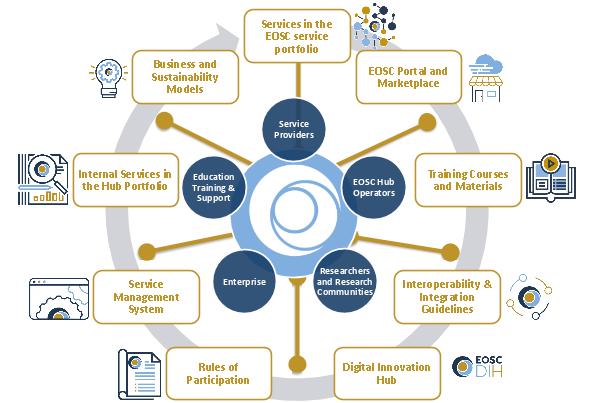This is a website for an H2020 project which concluded in 2019 and established the core elements of EOSC. The project's results now live further in www.eosc-portal.eu and www.egi.eu
This is a website for an H2020 project which concluded in 2019 and established the core elements of EOSC. The project's results now live further in www.eosc-portal.eu and www.egi.eu

The EOSC-hub project is a first implementation step of the European Open Science Cloud (EOSC) vision and since its beginning in 2018 has brought together multiple service providers to create a hub of diverse services available to all European researchers for their scientific work. EOSC-hub is providing the expertise and resources to enable an active usage of the EOSC and foster a culture of co-operation between researchers and EOSC service providers.
Now in 2020, the project is successful in establishing the integration and operation layer to join services and tools for scientific collaboration and make knowledge more accessible across Europe.
Q: What would you say are the main achievements of the project so far and how do they contribute to the development of EOSC?
A: The project’s main focus is to contribute to a single vision: EOSC as the shared space for research and innovation in Europe.
EOSC-hub’s main results so far (or key exploitable results - KERs - as we call them) have been supporting the building of the EOSC services, ensuring the quality of service components and providing best practices and tools for linking services to the Hub. The picture below provides an overview of the EOSC-hub KERs:

EOSC-hub Key Exploitable Results (KERs)
Specifically: the design, implementation and operations of the EOSC Portal and Marketplace, the definition and development of the EOSC Federating Core, the EOSC Service Management System (SMS), the Rules of Participation (RoP), the technical specifications and interoperability guidelines, the creation of the EOSC Digital Innovation Hub (DIH) for the involvement of the private sectors, the design of EOSC business models and the creation of a network of trainers and of a knowledge base.
For example, the EOSC Marketplace is now active with more than 260 services published. The onboarded service providers come from over 130 providers. The catalogue offers integrated additional features such as the ordering, enabling users to request access to EOSC services, and the user space, providing scientists with a personal space where they can combine EOSC services.
In parallel, the project has been integrating use cases from ESFRI, scientific communities, SMEs and industries. In this context, 30 thematic services have already been integrated from large research communities (CLARIN, CMS/DODAS, ECAS/ENES, GEOSS, OPENCoastS, WeNMR, EO Pillar, DARIAH, LifeWatch) and are now available to the European researchers through the EOSC Portal.
Another great example is the setup of the EOSC Digital Innovation Hub - a platform established to support industrial R&D and academic research in their accessing and sharing of EOSC tools and services.
Q: How does EOSC-hub contribute to innovating and advancing science, specifically?
A: To give a more comprehensive overview, we can mention the following aspects:
EOSC-hub has adopted a service integration and management approach to manage suppliers and integrate them to provide a single business-facing hub. As mentioned before, there are a growing number of services available now via the EOSC Marketplace, offered by both project partners and external providers such as research organisations and commercial providers.
EOSC-hub has been working on a series of activities to make EOSC an open and community-driven platform fostering open science in Europe. Notably the effort to define and promote the EOSC technical interoperability guidelines that allow data and software portability across multiple facilities and foster EOSC uptake. The project also designed an EOSC Technical Reference Architecture that includes functions, interfaces, APIs and standards as technical concepts.
Several scientific communities are benefitting of the EOSC-hub effort on fostering the adoption of advanced IT services. This has been achieved with different actions, particularly the publication of the e-infrastructure services in the EOSC Portal and Marketplace. EOSC-hub is now running 8 Competence Centers (CCs) to co-design and co-develop services for several scientific communities: ELIXIR, Fusion (ITER), Argo, SeaDataNet, EISCAT_3D, EPOS-ORFEUS, LOFAR and SKA, ICOS, eLTER and Disaster Mitigation communities.
Another action is the project’s Early Adopter Programme, an initiative launched in 2019 to select scientific communities interested in adopting and integrating multiple EOSC-hub services. The program has now 13 use cases on-board.
EOSC-hub has established a network of training experts that deliver trainings in different areas: access enabling and federation services, common services, data management planning, federated services management. So far, we have organised over 100 training events attended by more than 2000 people.
The EOSC-hub project has supported an access program enabling a number of the partners to provide EOSC services outside their usual user base resulting in new users from more than 100 countries. The initial engagement phase with EOSC stakeholders has been followed by provisioning of support and dedicated webinars on EOSC-hub solutions.
Q: You mentioned the EOSC Digital Innovation Hub. Can be it considered as an important project impact on the private sector?
A: Definitely. The EOSC Digital Innovation Hub (DIH) was successfully established at the end of 2018 and is now officially part of the EU Digital Innovation Hub catalogue. As mentioned previously, the DIH is a mechanism for SMEs to collaborate with universities and other public sector institutions in order to access latest technologies, technical services, research data, and human capital. A total of 11 business pilots have joined the EOSC hub DIH programme since its beginning. We are very proud of this result.
Tiziana Ferrari is Managing Director at the EGI Foundation and Coordinator of EOSC-hub.
Per Öster is Director of the Research Infrastructures unit at CSC and of EOSC-hub.